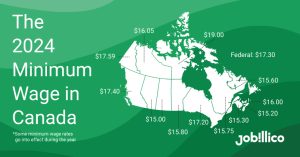Crafting A LinkedIn Presence for Job Seekers in 2024
 Publié le 8 April 2024
Publié le 8 April 2024
Building your professional brand online using the ultimate guide to crafting a LinkedIn Presence for job seekers in 2024.
Since its inception as a simple digital resume space, LinkedIn has evolved to become a crucial tool in 2024 for personal branding, networking, and showcasing professional achievements.
If you’re a professional looking for a job, cultivating a strong LinkedIn presence is essential in making you an attractive candidate to potential employers.
With this in mind, we’ll guide you every step of the way. Keep reading the ultimate guide to crafting a LinkedIn presence for job seekers in 2024 and land that job you’ve set your eyes on.
Levelling Up Your Skills for a Stellar LinkedIn Profile
65% of the skills needed for jobs are expected to change by 2030. Therefore, it’s crucial you continuously learn and adapt so that you can enhance your LinkedIn presence by exhibiting a strong skillset.
Here is what you need to do to build a skillset that’ll serve you well now and in the times to come, and how to showcase it on LinkedIn:
Identifying Skills and Trends
The first step to leveling up your skillset is identifying the latest trends in your field, as well as common skills and qualifications that employers are seeking. You can then tailor your LinkedIn professional development to meet these requirements.
For trends, excellent resources you’ll need are LinkedIn industry groups, professional forums, and relevant publications. For the desired skills and qualifications, look at multiple LinkedIn job openings and see which ones frequently appear.
Once you know where you need to progress, it’s time for the how part of the equation, so look for relevant courses on the best upskilling platforms for workforces, whose certificates can be added on LinkedIn:
Best Platforms for Acquiring Relevant Certificates
- Coursera & edX: These two platforms offer courses from universities around the world, with many of the courses taught by industry professionals and academics at the forefront of their fields. Except to gain both theoretical knowledge and practical insights.
- Udemy: This one’s focused on courses teaching specific skills or software. The platform offers a vast selection of high-quality courses that are often updated to include the latest practices.
- LinkedIn Learning: A great resource for courses specifically designed for LinkedIn professional development and boosting your career. It benefits from LinkedIn’s vast data on job trends and skills demand, which it uses to recommend personalized learning paths.
Armed with old and new certificates, you can – and should – showcase them on LinkedIn in the ‘Licenses & Certifications’ Section, including the issuing organization and the date you obtained the certificate.
Optimizing LinkedIn’s “Skills & Endorsements” Section
As LinkedIn allows you to reorder skills, meaning you can align with them your current job goals.
Start with your strongest and most relevant skills at the top, including a balance of talents to demonstrate versatility: technical skills, languages, and any other competencies relevant to your profession. Moreover, soft skills are becoming particularly beneficial, as many employers are willing to train the right candidate if they demonstrate commitment and a willingness to learn.
As for endorsements, think about colleagues, supervisors, or clients familiar with your work who can provide credibility to your stated skills.
When reaching out, remind the person of a project or situation where you demonstrated the skill you’re seeking an endorsement for. To build goodwill, offer to reciprocate and promote some of their professional abilities.
Creating a Professional LinkedIn Profile
Having a polished and professionally set up LinkedIn user profile is essential for getting LinkedIn job opportunities. Here are some key elements to consider:
- Summary: Engagingly highlight your achievements, skills, and what you’re looking for in your next role. A LinkedIn summary generator tool can help you improve your summary after you paste it into the tool and set the appropriate tone.
- Headline: It should go beyond just your job title and include your specialization or what you’re passionate about. For example: “Digital Marketing Specialist | SEO & SEM Enthusiast | Helping Brands Build Online Presence.”
- Profile picture: Choose a professional, high-quality headshot with good lighting. Aim for an approachable expression and use a simple, uncluttered background.
- Consistency: Keep your work experience and skills updated and consistent with your CV and across your LinkedIn profile. Discrepancies can raise questions about your attention to detail, or even worse, honesty.
You may check our dedicated article on creating a standout LinkedIn user profile for more in-depth advice.
Standing Out in the LinkedIn Community
To significantly enhance your LinkedIn visibility and establish yourself as an expert in your industry, you need more than a well-optimized profile.
Creating valuable LinkedIn content and interacting meaningfully with your network are key strategies to utilize here. Here’s how:
LinkedIn Content Creation Strategies
Start by considering what insights, experiences, and knowledge would be valuable to your connections and for broader LinkedIn networking.
Then, get to work. To keep your audience engaged, you’ll need to mix up your LinkedIn content formats: This includes:
- Articles: In-depth posts about industry trends, helpful advice for others, and lessons learned from your career.
- Short posts: Quick tips, industry news, or questions to spark discussions.
- Videos: Provide insights in a more personal and engaging way through videos, whether it’s, industry analysis, short tutorials, or career advice.
- Infographics: Use infographics to share content that summarizes info in a visually appealing and easy-to-digest format, which is ideal for complex topics or data.
- LinkedIn Stories: A great feature for sharing more casual, behind-the-scenes content: insights from your workday, industry events, and quick tips.
Keep in mind, regular posting is necessary to keep you at the top of mind within your network. Establish a content calendar to maintain a consistent posting schedule while avoiding overwhelming your audience.
If you do this right, you’ll enhance your presence on LinkedIn and find people commenting on your LinkedIn content. Take the time to respond to encourage more interaction, but also to foster a sense of budding community on your profile.
Meaningful LinkedIn Interaction
Essentially, this is about two things: adding value and fostering relationships.
Rather than just leaving simple comments like “Wow, that was a great post!”, contribute with meaningful insights instead. This adds value to the discussion and shows you’ve found the content engaging.
Another action that leads to deeper discussions and demonstrates genuine interest is asking questions about the posts or related opinions.
Apart from your existing LinkedIn networking, groups on this platform are a goldmine for connecting with like-minded professionals and discussing shared topics. There, your valuable contributions won’t go unnoticed.
In addition to adding value, there’s celebrating other users, both a nice and constructive approach. Congratulate your connections on their achievements with personalized messages – stand out among generic comments.
And, if you come across interesting content, share it with your network. Just like meaningful comments and questions, this not only positions you as industry-proficient, but also helps build healthy relationships and overall LinkedIn visibility.
Outreach Approaches to LinkedIn Job Opportunities
Applying to LinkedIn job openings isn’t the only way to take advantage of LinkedIn job opportunities.
You can also take a more direct approach and reach out to a company’s HR professionals to place yourself on their potential candidates’ map.
1. Crafting Impactful Job Inquiries
First, you need to do your homework. Researching the company thoroughly is one of the key strategies for job application enhancement and you need to understand the company’s goals and culture.
Look into the HR professionals themselves – if they’ve shared articles or posts, do read them to gather insights into their interests and professional values.
As for writing the actual job inquiry, best practice tips are as follows:
- Define your value proposition: Concisely highlight your unique skills or experiences that align with the company’s needs.
- Personalize your message: To show genuine interest, mention something specific about the company or the HR’s recent post.
- Use a professional tone: While it’s important to be personable, maintain a professional tone throughout your message, avoid slang, and overly casual language.
- Mention hybrid-work availability: With the ever-increasing number of hybrid job listings, showing adaptability to work in hybrid settings will make your profile stand out.
- Follow up wisely: If you don’t hear back, it’s appropriate to send one, politely phrased, follow-up message after a week or two.
An effective template to adapt goes something like this:
“Hi [Name],
I was truly inspired by [Company]’s recent initiative on [Project/Initiative], especially how you’ve approached [specific detail]. Your commitment to [something related to company culture or values] resonates deeply with me.
With a background in [Your Field] and hands-on experience in [a specific skill or project related to the job], I’ve successfully [mention a relevant achievement or project that aligns with the company’s goals or project].
Could we possibly discuss any opportunities where my background and skills could contribute to the success of your team? I’m eager to explore how I can add value to [Company] and support your goals.
Best regards,
[Your Name]”
2. Establishing Meaningful Connections for Career Guidance
Another approach to reaching HR is to frame your outreach as seeking advice or insights rather than directly asking for a job.
Why? Because it positions you as someone who is proactive about learning and growth, and lets you establish a connection based on mutual interests and respect. Consequentially, you’re more likely to be remembered for opportunities that arise in the future.
Use these tips:
- Introduction: Briefly introduce yourself, including your current role or area of study, and explain why you’re reaching out to them specifically.
- Ask specific questions: Their career path, the challenges they’ve faced, or trends in the industry are potential questions that show you value their expertise and are interested in learning.
- Seek guidance: Express your interest in a particular area of their work or the industry, like recommendations on skills to develop, resources to consult, or strategies for tackling challenges.
- Propose a conversation: Suggest a brief phone call, video chat, or even just an email exchange, whatever seems most appropriate given their position and your request.
And, here’s a template:
Hello [Name],
I hope this message finds you well. My name is [Your Name], and I’m currently [Your Current Role or Area of Study], with a keen interest in [Industry/Field]. I’ve been following your work and am impressed by your contributions to [specific area or project]. Your insights on [Topic] particularly resonated with me, reflecting both depth and innovation.
As I navigate my career path within [Industry/Field], I’m eager to learn from those who’ve substantially impacted the field. Your career journey, especially your experiences with [mention any known challenges or achievements they’ve had], offers valuable lessons that I believe could guide me through similar challenges.
I’m particularly interested in understanding [ask a specific question about their career path, a challenge they’ve faced, or industry trends].
Would you be open to sharing your insights over a brief [phone call, video chat, or email exchange]? I’m flexible and can adapt to the communication method that best suits your schedule. Your guidance would be incredibly valuable to me, and I’d be grateful for the opportunity to learn from your experiences.
Thank you very much for considering my request. I look forward to potentially hearing from you.
Best regards,
[Your Name]
Mastering LinkedIn to Unlock Your Next Career Opportunity
In this guide, we’ve covered the best practices for crafting a LinkedIn presence for job seekers in 2024.
To briefly summarize, by upskilling through reputable platforms and showcasing these efforts on your LinkedIn profile, you gain industry credentials.
You cement those by engaging your network through valuable content and interactions that help with LinkedIn job opportunities.
And, if you adopt a strategic approach to the often essential step of job inquiries, you vastly improve your chances of finally sealing the deal.
So, here’s to refining your professional brand and landing your dream job on LinkedIn!







